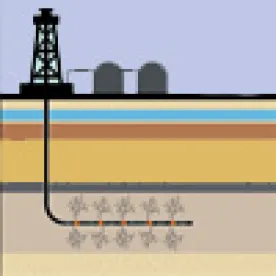The ban comes in light of a report from the New York State Department of Health claiming there is insufficient information to understand the health risks.
On December 17, New York Governor Andrew Cuomo’s administration announced that the State of New York will ban hydraulic fracturing in response to conclusions presented in a report prepared by the New York State Department of Health (NYSDOH) and comments made by the Acting Health Commissioner and the New York State Department of Environmental Conservation (NYSDEC) Commissioner.
In 2009, the NYSDEC was directed to determine the suitability of hydraulic fracturing and to prepare a Supplemental Generic Environmental Impact Statement. Under New York law as interpreted by NYSDEC, an Environmental Impact Statement (EIS) is required to accompany permit applications for horizontal drilling and natural gas well completions. A Generic Environmental Impact Statement (GEIS) can be used to fulfill this requirement and to prevent the need for an individual EIS for each natural gas well permit application. In 2012, as part of this process, the NYSDEC requested an opinion from the NYSDOH on the health risks associated with hydraulic fracturing. At a year-end cabinet meeting, the Acting Health Commissioner announced that he could not support hydraulic fracturing, and NYSDEC Commissioner Joseph Martens said that a five-year study by NYSDEC on fracking will be released next year. Mr. Martens is quoted as stating, “I will then issue a legally binding findings statement prohibiting [fracking] in New York State.”
Acting New York State Health Commissioner Howard Zucker announced the NYSDOH conclusion and also commented personally that he would not allow his family to drink tap water in an area where hydraulic fracturing occurred, a comment that apparently garnered no mutual support at the cabinet meeting. The NYSDOH report itself is inconclusive. The report’s executive summary states the following:
[I]t is apparent that the science surrounding HVHF [High Volume Hydraulic Fracturing] activity is limited, only just beginning to emerge, and largely suggests only hypotheses about potential public health impacts that need further evaluation . . . . As with most complex human activities in modern societies, absolute scientific certainty regarding the relative contributions of positive and negative impacts of HVHF on public health is unlikely to ever be attained. In this instance, however, the overall weight of the evidence from the cumulative body of information contained in this Public Health Review demonstrates that there are significant uncertainties about the kinds of adverse health outcomes that may be associated with HVHF, the likelihood of the occurrence of adverse health outcomes, and the effectiveness of some of the mitigation measures in reducing or preventing environmental impacts which could adversely affect public health.
The remainder of the 184-page report refers to many unpublished and non–peer reviewed reports, at least some of which were funded by groups opposed to the natural gas industry. On the other hand, the NYSDOH report lists but does not discuss nor give credibility to recent peer-reviewed and published studies. For example, the NYSDOH bibliography lists the 2014 U.S. Department of Energy’s National Environmental Technology Laboratory (NETL) study that used tracers to conclude there is no evidence of gas or brine migration from Marcellus Shale wells. However, nowhere in the NYSDOH report is the NETL study discussed. Similarly, the report mentions the 2013 Fryzek retrospective assessment, which concluded that no increase of childhood cancers occurred after HVHF commenced, but NYSDOH disregards that work, claiming there is “uncertainty about the strength of the study conclusions.” Instead, for example, the NYSDOH gives weight to the Southwest Pennsylvania – Environmental Health Project’s unpublished and no-longer-available website presentation, which describes self-reported symptoms from a small number of individuals who reported these claimed symptoms to a non-healthcare organization. These examples are typical of what can be found in the NYSDOH report and its conclusions. Thus, the decision to impose a ban on the unconventional shale industry in New York would appear to be legally questionable to the extent that it relies on a concern for what might happen as opposed to the great weight of information and evidence that these concerns are not justified.
Impact
Ultimately, the ban is expected to be overturned. The owners of oil and gas rights have a basis for claiming that they are being deprived of legitimate economic interests without necessary governmental basis for this restriction. Those opposed to unconventional shale development in other areas of the country will attempt to use the NYSDOH report to further their interests, but this will have little impact because reviewing courts and governmental agencies will have access to the underlying studies and will have the ability to give these studies appropriate weight. Thus, until the ban is overturned, exploration and production of the vast unconventional shale deposits in the United States and elsewhere will continue, and New York will have to wait for its opportunity.





 />i
/>i

